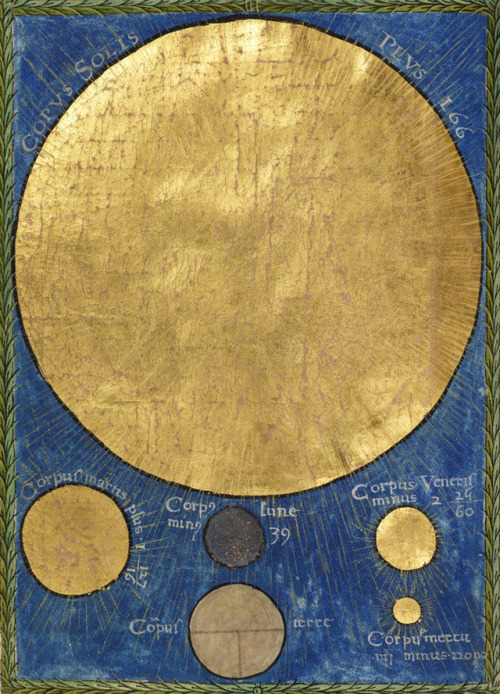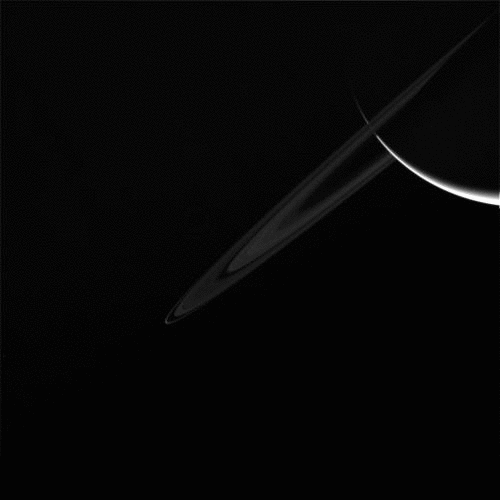'News & Features': Via #NASA_APP
'News & Features': via #NASA_APP
More Posts from Needingsomespace and Others


celestial bodies
Christianus Prolianus, Astronomia, Naples 1478
Manchester, John Rylands University Library, Latin MS 53, fol. 58v
Don’t cry for Cassini: il lento suicidio nell’atmosfera del Signore degli Anelli
La sonda Cassini, lanciata il 15 ottobre 1997, è entrata in orbita attorno a Saturno il primo luglio del 2004. Prima di Cassini, Saturno veniva osservato quasi esclusivamente da Terra con l'eccezione delle immagini e dei dati raccolti dalle sonde Pioneer 11 e Voyager 1 e Voyager 2, che hanno effettuato dei flyby del pianeta, rispettivamente nel 1979, nel 1980 e nel 1981.

Cassini ha cambiato completamente la nostra visione di Saturno! Nei 12 anni trascorsi a orbitare attorno al pianeta, a fotografare e studiare i suoi anelli e le sue lune, la sonda ha percorso circa 2.2 miliardi di miglia dal suo arrivo nel 2004 e ha raccolto circa 600 GB di dati, scoperto 10 lune, inviato circa 380.000 immagini.
Oggi 30 novembre 2016 la missione Cassini della NASA inizierà una serie di orbite che la porteranno a spingersi oltre il bordo esterno degli anelli principali di Saturno (oltre le orbite dell'anello F), a 7.800 chilometri di distanza.

Gli ingegneri NASA stanno effettuando correzioni di rotta volte a modificare l'orbita di Cassini in modo da aumentare la sua inclinazione rispetto all'equatore e agli anelli di Saturno e di beneficiare di una "spinta" gravitazionale di Titano per inserirsi nella prima delle fasi conclusive della sua missione. Grazie a questo passaggio Cassini orbiterà attorno al polo Nord e al polo Sud del pianeta fino al 22 aprile 2017, tuffandosi ogni sette giorni nel bordo esterno degli anelli principali, per un totale di 20 volte, sfiorandoli per raccogliere campioni di molecole e gas

Durante queste orbite, Cassini passerà a circa 90.000 chilometri sopra alle nubi di Saturno: sarà una fase emozionante, ma sarà solo un preludio a quello che ci attenderà a partire dal mese di aprile, quando la sonda inizierà il Gran Finale, che terminerà il 15 settembre con il tuffo nell'atmosfera di Saturno.
Il motivo che ha portato gli scienziati a decidere per questa soluzione è che la sonda sta per esaurire il carburante e c'è l'esigenza di tutelare le lune di Saturno potenzialmente abitabili. A questo punto la soluzione scientificamente migliore è quella di progettare il fine missione in modo da condurre un'indagine straordinaria e non creare problemi al sistema di Saturno.
Cassini Mission: What’s Next?
It’s Friday, Sept. 15 and our Cassini mission has officially come to a spectacular end. The final signal from the spacecraft was received here on Earth at 7:55 a.m. EDT after a fateful plunge into Saturn’s atmosphere.

After losing contact with Earth, the spacecraft burned up like a meteor, becoming part of the planet itself.

Although bittersweet, Cassini’s triumphant end is the culmination of a nearly 20-year mission that overflowed with discoveries.
But, what happens now?
Mission Team and Data
Now that the spacecraft is gone, most of the team’s engineers are migrating to other planetary missions, where they will continue to contribute to the work we’re doing to explore our solar system and beyond.

Mission scientists will keep working for the coming years to ensure that we fully understand all of the data acquired during the mission’s Grand Finale. They will carefully calibrate and study all of this data so that it can be entered into the Planetary Data System. From there, it will be accessible to future scientists for years to come.

Even beyond that, the science data will continue to be worked on for decades, possibly more, depending on the research grants that are acquired.
Other team members, some who have spent most of their career working on the Cassini mission, will use this as an opportunity to retire.
Future Missions
In revealing that Enceladus has essentially all the ingredients needed for life, the mission energized a pivot to the exploration of “ocean worlds” that has been sweeping planetary science over the past couple of decades.

Jupiter’s moon Europa has been a prime target for future exploration, and many lessons during Cassini’s mission are being applied in planning our Europa Clipper mission, planned for launch in the 2020s.

The mission will orbit the giant planet, Jupiter, using gravitational assists from large moons to maneuver the spacecraft into repeated close encounters, much as Cassini has used the gravity of Titan to continually shape the spacecraft’s course.
In addition, many engineers and scientists from Cassini are serving on the new Europa Clipper mission and helping to shape its science investigations. For example, several members of the Cassini Ion and Neutral Mass Spectrometer team are developing an extremely sensitive, next-generation version of their instrument for flight on Europa Clipper. What Cassini has learned about flying through the plume of material spraying from Enceladus will be invaluable to Europa Clipper, should plume activity be confirmed on Europa.

In the decades following Cassini, scientists hope to return to the Saturn system to follow up on the mission’s many discoveries. Mission concepts under consideration include robotic explorers to drift on the methane seas of Titan and fly through the Enceladus plume to collect and analyze samples for signs of biology.

Atmospheric probes to all four of the outer planets have long been a priority for the science community, and the most recent recommendations from a group of planetary scientists shows interest in sending such a mission to Saturn. By directly sampling Saturn’s upper atmosphere during its last orbits and final plunge, Cassini is laying the groundwork for an potential Saturn atmospheric probe.

A variety of potential mission concepts are discussed in a recently completed study — including orbiters, flybys and probes that would dive into Uranus’ atmosphere to study its composition. Future missions to the ice giants might explore those worlds using an approach similar to Cassini’s mission.
Learn more about the Cassini mission and its Grand Finale HERE.
Follow the mission on Facebook and Twitter for the latest updates.
Make sure to follow us on Tumblr for your regular dose of space: http://nasa.tumblr.com.





February 24, 1969 – Apollo 11 moonwalkers Neil Armstrong and Buzz Aldrin train for the Moon by going on a geology field trip to the Sierra Blanca region in West Texas. (NASA)
Five Famous Pulsars from the Past 50 Years
Early astronomers faced an obstacle: their technology. These great minds only had access to telescopes that revealed celestial bodies shining in visible light. Later, with the development of new detectors, scientists opened their eyes to other types of light like radio waves and X-rays. They realized cosmic objects look very different when viewed in these additional wavelengths. Pulsars — rapidly spinning stellar corpses that appear to pulse at us — are a perfect example.

The first pulsar was observed 50 years ago on August 6, 1967, using radio waves, but since then we have studied them in nearly all wavelengths of light, including X-rays and gamma rays.
Typical Pulsar
Most pulsars form when a star — between 8 and 20 times the mass of our sun — runs out of fuel and its core collapses into a super dense and compact object: a neutron star.

These neutron stars are about the size of a city and can rotate slowly or quite quickly, spinning anywhere from once every few hours to hundreds of times per second. As they whirl, they emit beams of light that appear to blink at us from space.
First Pulsar
One day five decades ago, a graduate student at the University of Cambridge, England, named Jocelyn Bell was poring over the data from her radio telescope - 120 meters of paper recordings.

Image Credit: Sumit Sijher
She noticed some unusual markings, which she called “scruff,” indicating a mysterious object (simulated above) that flashed without fail every 1.33730 seconds. This was the very first pulsar discovered, known today as PSR B1919+21.
Best Known Pulsar
Before long, we realized pulsars were far more complicated than first meets the eye — they produce many kinds of light, not only radio waves. Take our galaxy’s Crab Nebula, just 6,500 light years away and somewhat of a local celebrity. It formed after a supernova explosion, which crushed the parent star’s core into a neutron star.

The resulting pulsar, nestled inside the nebula that resulted from the supernova explosion, is among the most well-studied objects in our cosmos. It’s pictured above in X-ray light, but it shines across almost the entire electromagnetic spectrum, from radio waves to gamma rays.
Brightest Gamma-ray Pulsar
Speaking of gamma rays, in 2015 our Fermi Gamma-ray Space Telescope discovered the first pulsar beyond our own galaxy capable of producing such high-energy emissions.

Located in the Tarantula Nebula 163,000 light-years away, PSR J0540-6919 gleams nearly 20 times brighter in gamma-rays than the pulsar embedded in the Crab Nebula.
Dual Personality Pulsar
No two pulsars are exactly alike, and in 2013 an especially fast-spinning one had an identity crisis. A fleet of orbiting X-ray telescopes, including our Swift and Chandra observatories, caught IGR J18245-2452 as it alternated between generating X-rays and radio waves.

Scientists suspect these radical changes could be due to the rise and fall of gas streaming onto the pulsar from its companion star.
Transformer Pulsar
This just goes to show that pulsars are easily influenced by their surroundings. That same year, our Fermi Gamma Ray Space Telescope uncovered another pulsar, PSR J1023+0038, in the act of a major transformation — also under the influence of its nearby companion star.

The radio beacon disappeared and the pulsar brightened fivefold in gamma rays, as if someone had flipped a switch to increase the energy of the system.
NICER Mission
Our Neutron star Interior Composition Explorer (NICER) mission, launched this past June, will study pulsars like those above using X-ray measurements.

With NICER’s help, scientists will be able to gaze even deeper into the cores of these dense and mysterious entities.
For more information about NICER, visit https://www.nasa.gov/nicer
Make sure to follow us on Tumblr for your regular dose of space: http://nasa.tumblr.com

Il codice scritto in linguaggio assembly che portò l'America sulla Luna nel '69 è stato pubblicato su GitHub. La routine di accensione dei motori principali si chiama BURN_BABY_BURN Girano altre routine di gestione dell'allunaggio, dove pare ci siano stringhe di indicazioni per gli astronauti "GIRARE QUEL COSO SCEMO LÌ" "CONTROLLARE SE DICE CAZZATE"

Enceladus striated surface as seen by Cassini .
js

Ship Ready for Return (Unfinished) - Chesley Bonestell

Una futura missione per l'atterraggio una sonda robotizzata sulla luna ghiacciata di Giove, Europa, potrebbe essere nei progetti della NASA. La relazione sul potenziale valore scientifico di tale missione, si propone di coinvolgere la comunità scientifica più ampia sui meriti di tale ricerca. L'obiettivo primario è la ricerca di prove di vita.